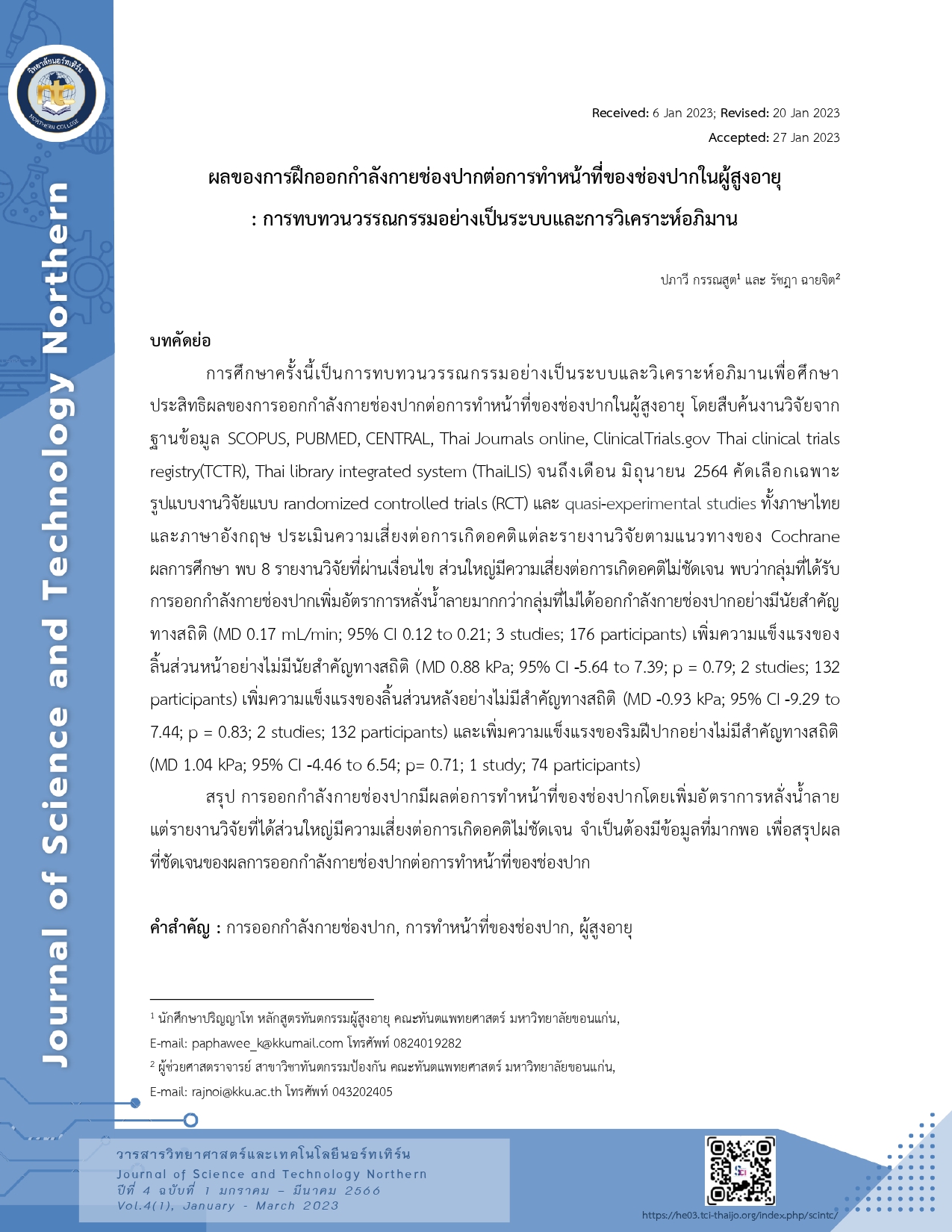ผลของการฝึกออกกำลังกายช่องปากต่อการทำหน้าที่ของช่องปากในผู้สูงอายุ: การทบทวนวรรณกรรมอย่างเป็นระบบและการวิเคราะห์อภิมาน
คำสำคัญ:
การออกกำลังกายช่องปาก, การทำหน้าที่ของช่องปาก, ผู้สูงอายุบทคัดย่อ
การศึกษาครั้งนี้เป็นการทบทวนวรรณกรรมอย่างเป็นระบบและวิเคราะห์อภิมานเพื่อศึกษาประสิทธิผลของการออกกำลังกายช่องปากต่อการทำหน้าที่ของช่องปากในผู้สูงอายุ โดยสืบค้นงานวิจัยจากฐานข้อมูล SCOPUS , PUBMED , CENTRAL , Thai Journals online , ClinicalTrials.gov Thai clinical trials registry (TCTR) , Thai library integrated system (ThaiLIS) จนถึงเดือน มิถุนายน 2564 คัดเลือกเฉพาะรูปแบบงานวิจัยแบบ randomized controlled trials (RCT) และ quasi-experimental studies ทั้งภาษาไทยและภาษาอังกฤษ ประเมินความเสี่ยงต่อการเกิดอคติแต่ละรายงานวิจัยตามแนวทางของ Cochrane ผลการศึกษา พบ 8 รายงานวิจัยที่ผ่านเงื่อนไข ส่วนใหญ่มีความเสี่ยงต่อการเกิดอคติไม่ชัดเจน พบว่ากลุ่มที่ได้รับการออกกำลังกายช่องปากเพิ่มอัตราการหลั่งน้ำลาย มากกว่ากลุ่มที่ไม่ได้ออกกำลังกายช่องปากอย่างมีนัยสำคัญทางสถิติ (MD 0.17 mL/min; 95% CI 0.12 to 0.21; 3 studies; 176 participants) เพิ่มความแข็งแรงของลิ้นส่วนหน้าอย่างไม่มีนัยสำคัญทางสถิติ (MD 0.88 kPa; 95% CI -5.64 to 7.39; p = 0.79; 2 studies; 132 participants) เพิ่มความแข็งแรงของลิ้นส่วนหลังอย่างไม่มีสำคัญทางสถิติ (MD -0.93 kPa; 95% CI -9.29 to 7.44; p = 0.83; 2 studies; 132 participants) และเพิ่มความแข็งแรงของริมฝีปากอย่างไม่มีสำคัญทางสถิติ (MD 1.04 kPa; 95% CI -4.46 to 6.54; p= 0.71; 1 study; 74 participants)
สรุป การออกกำลังกายช่องปากมีผลต่อการทำหน้าที่ของช่องปากโดยเพิ่มอัตราการหลั่งน้ำลาย แต่รายงานวิจัยที่ได้ส่วนใหญ่มีความเสี่ยงต่อการเกิดอคติไม่ชัดเจน จำเป็นต้องมีข้อมูลที่มากพอ เพื่อสรุปผลที่ชัดเจนของผลการออกกำลังกายช่องปากต่อการทำหน้าที่ของช่องปาก
เอกสารอ้างอิง
Cho, E.-P., Hwang, S.-J., Clovis, Joanne. B., Lee, T.-Y., Paik, D.-I., & Hwang, Y.-S. (2012). Enhancing the quality of life in elderly women through a programme to improve the condition of salivary hypofunction: Oral health promotion programme and quality of life.
Gerodontology. 29(2), e972–e980.
Delwel, S., Scherder, E. J. A., Perez, R. S. G. M., Hertogh, C. M. P. M., Maier, A. B., & Lobbezoo, F. (2018). Oral function of older people with mild cognitive impairment or dementia.Journal of Oral Rehabilitation. 45(12), 990–997.
Hakuta, C., Mori, C., Ueno, M., Shinada, K., & Kawaguchi, Y. (2009). Evaluation of an oral function promotion programme for the independent elderly in Japan. Gerodontology. 26(4), 250–258.
Hägglund, P., Hägg, M., Wester, P., & Levring Jäghagen, E. (2019). Effects of oral neuromuscular training on swallowing dysfunction among older people in intermediate care—A cluster randomised, controlled trial. Age and Ageing. 48(4), 533–540.
Ibayashi, H., Fujino, Y., Pham, T.-M., & Matsuda, S. (2008). Intervention Study of Exercise Program for Oral Function in Healthy Elderly People. The Tohoku Journal of Experimental Medicine. 215(3), 237–245.
Kim, H.-J., Lee, J.-Y., Lee, E.-S., Jung, H.-J., Ahn, H.-J., & Kim, B.-I. (2 0 1 9 ) . Improvements in oral functions of elderly after simple oral exercise. Clinical Interventions in Aging. 14, 915–924.
Kim, H.-J., Lee, J.-Y., Lee, E.-S., Jung, H.-J., Ahn, H.-J., Jung, H. I., & Kim, B.-I. (2021). Simple oral exercise with chewing gum for improving oral function in older adults. Aging Clinical and Experimental Research. 33(4), 1023–1031.
Lamster, I. B., Asadourian, L., Del Carmen, T., & Friedman, P. K. (2016). The aging mouth: Differentiating normal aging from disease. Periodontology 2000. 72(1), 96–107.
Lee, K., Jung, E., & Choi, Y. (2020). Effects of lingual exercises on oral muscle strength and salivary flow rate in elderly adults: A randomized clinical trial. Geriatrics & Gerontology International. 20(7), 697–703.
Minakuchi, S., Tsuga, K., Ikebe, K., Ueda, T., Tamura, F., Nagao, K., Furuya, J., Matsuo, K., Yamamoto,
K., Kanazawa, M., Watanabe, Y., Hirano, H., Kikutani, T., & Sakurai, K. (2 0 1 8 ) . Oral hypofunction in the older population: Position paper of the Japanese Society of Gerodontology in 2016. Gerodontology. 35(4), 317–324.
Morisaki, N. (2 0 1 8 ) . Effects of Oral Exercise on Oral Function among Japanese Dependent Elderly Individuals Living in Nursing Facilities. International Journalof Nursing & Clinical Practices. 5, 301-304.
Nam, M., & Uhm, D. (2016). A comparative study of the effects of intra and extracircumoral exercise for older people on oral health at nursing homes: A non-equivalent trial. Journal of Advanced Nursing. 72(9), 2114–2123.
Saito, M., Shimazaki, Y., Nonoyama, T., & Tadokoro, Y. (2021) . Association of oral health factors related to oral function with mortality in older Japanese. Gerodontology. 38(2), 166–173.
Seo, K., & Kim, H.-N. (2020). Effects of oral health programmes on xerostomia in communitydwelling elderly: A systematic review and meta-analysis. International Journal of Dental Hygiene. 18(1), 52–61.
Seo, S.-Y., Choi, Y.-Y., Lee, K.-H., & Jung, E.-S. (2021). Improvement in oral function after an oral exercise program including whole-body exercises. Journal of Korean Society of Dental Hygiene. 21(1), 5–16.
Smaoui, S., Langridge, A., & Steele, C. M. (2020). The Effect of Lingual Resistance Training Interventions on Adult Swallow Function: A Systematic Review. Dysphagia. 35(5), 745–761.
Takamoto, K., Saitoh, T., Taguchi, T., Nishimaru, H., Urakawa, S., Sakai, S., Ono, T., & Nishijo, H. (2018). Lip closure training improves eating behaviors and prefrontal cortical hemodynamic activity and decreases daytime sleep in elderly persons. Journal of Bodywork and Movement Therapies. 22(3), 810–816.
World Health Organization. (2022). Ageing and health. https://www.who.int/news-room/factsheets/detail/ageing-and-health.

ดาวน์โหลด
เผยแพร่แล้ว
รูปแบบการอ้างอิง
ฉบับ
ประเภทบทความ
สัญญาอนุญาต
ลิขสิทธิ์ (c) 2023 วารสารวิทยาศาสตร์และเทคโนโลยีนอร์ทเทิร์น

อนุญาตภายใต้เงื่อนไข Creative Commons Attribution-NonCommercial-NoDerivatives 4.0 International License.






